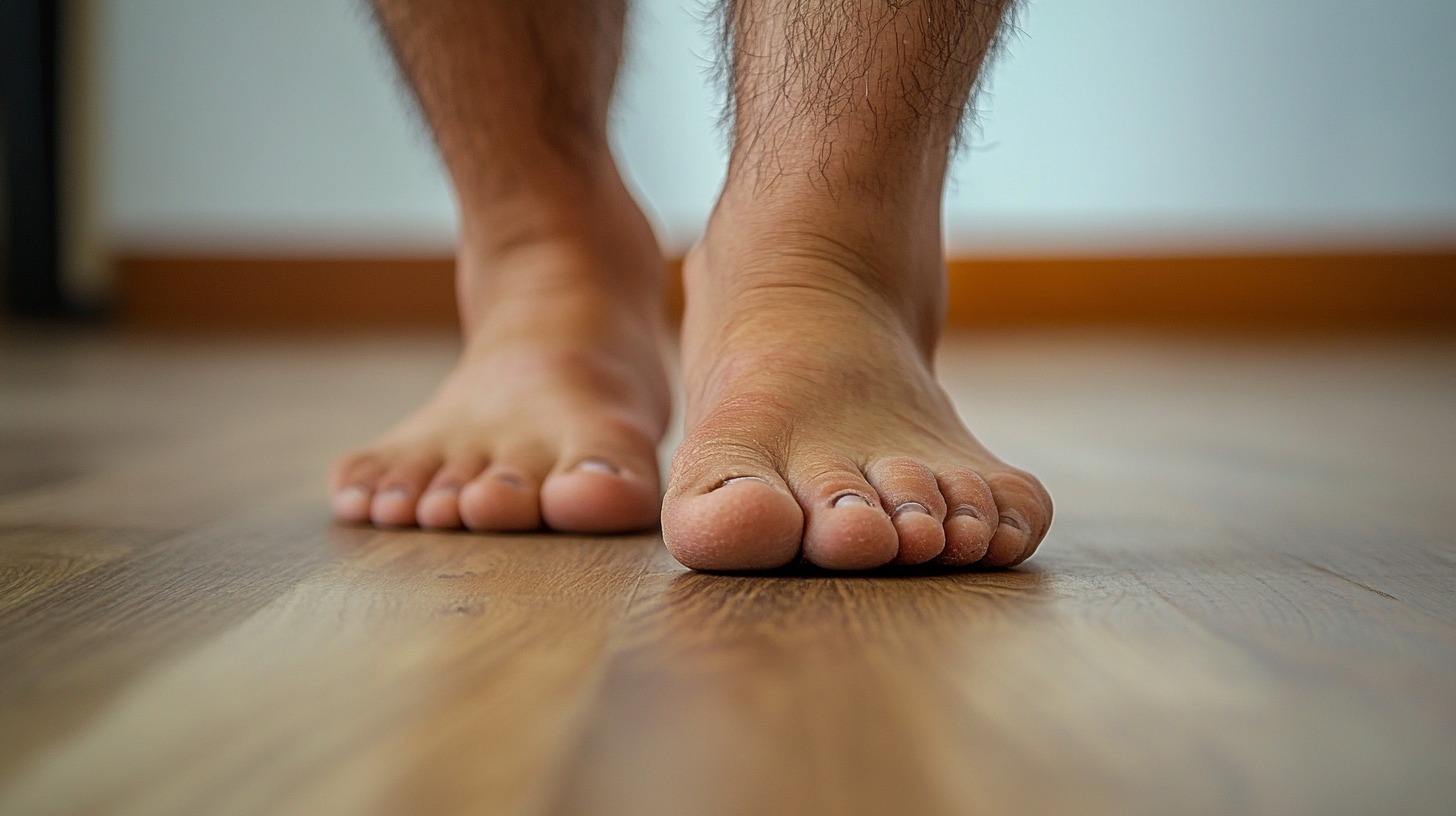Remarkably, studies show that nearly 15% of people with diabetes will develop foot ulcers at some point in their lives, underscoring the critical importance of foot health. Sores on the bottom of feet can significantly hinder mobility and diminish quality of life.
These discomforts often stem from various underlying issues, such as infections and dermatological diseases, with foot ulcers, blisters on feet, and cracked heels being among the most common types. Understanding the causes and symptoms of these ailments is essential for timely treatment, as neglected issues can escalate into severe complications like amputations.
Engaging with healthcare professionals, including podiatrists and wound care experts, becomes crucial in managing risks associated with foot soreness and ensuring effective foot pain relief.
Key Takeaways
- Foot ulcers affect approximately 15% of individuals with diabetes.
- Common forms of sores include foot ulcers, blisters on feet, and cracked heels.
- Timely treatment is crucial to prevent severe complications.
- Collaboration with healthcare professionals aids in proper management.
- Understanding the symptoms facilitates effective foot soreness treatment.
Understanding Foot Ulcers
Foot ulcers represent a critical health issue, primarily manifesting as open sores or lesions that resist healing over an extended time. These conditions predominantly affect the skin and underlying tissues of the feet and ankles. Understanding foot ulcers involves delving into their classification, risk factors, and the specific populations affected by these painful wounds.
What Are Foot Ulcers?
Foot ulcers are essentially broken-down areas of skin that can develop due to various underlying medical conditions. They frequently result from chronic diseases like diabetes or peripheral artery disease, leading to significant complications. The slow healing process raises the risk of infections and may result in further complications that exacerbate the patient’s health.
Types of Foot Ulcers
Different types of foot ulcers exist, each linked to distinct causes and presenting unique characteristics. The three primary categories include:
- Diabetic Foot Ulcers: Often referred to as neurotrophic ulcers, these typically arise in patients with diabetes, especially those experiencing nerve damage due to neuropathy. They frequently occur at pressure points, making them particularly concerning.
- Arterial Ulcers: These ulcers result from severely restricted blood flow, which hampers oxygen delivery to the tissues. The lack of circulation can lead to tissue death, making treatment essential to prevent further complications.
- Venous Ulcers: Although not highlighted in earlier discussions, these occur due to poor blood return to the heart, causing skin breakdown around the ankles.
Who is at Risk?
Certain populations face a higher risk of developing foot ulcers. Individuals with diabetes are particularly vulnerable, especially those with coexisting neuropathy. Seniors, who may have compromise peripheral circulation, also fall into the high-risk category. Individuals with a history of arterial disease or chronic conditions exacerbating blood flow problems must adopt preventative measures to protect their feet from potential ulcers.
Sores on Bottom of Feet Causes, Symptoms and Treatments
Sores on the bottom of the feet can arise from a variety of underlying conditions. Understanding the common causes of sores helps in identifying appropriate foot soreness treatment while addressing symptoms effectively.
Common Causes of Sores
Several factors contribute to the formation of sores on the feet. Common causes include:
- Diabetic neuropathy leading to nerve damage
- Venous insufficiency affecting blood circulation
- Physical trauma from injuries or friction
- Foot infections that develop from bacteria or fungi
- Plantar warts caused by the human papillomavirus
- Fissured skin due to environmental elements, such as dryness or harsh footwear
Symptoms Associated with Sores
The symptoms experienced with foot sores can vary based on their cause. Commonly reported symptoms include:
- Swelling in the affected area
- Pain or tenderness when walking
- Changes in skin appearance, like discoloration
- Crusting or oozing from the sore
Risk Factors Leading to Foot Sores
Certain individuals may be more susceptible to foot sores due to specific risk factors. Key risk factors include:
- Diabetes: High blood sugar levels can impair healing.
- Obesity: Increased pressure on the feet can lead to sores.
- History of foot injuries: Previous damages may predispose to sores.
- Lifestyle choices: Tobacco and alcohol use can impair circulation.
- Poor circulation: Conditions that affect blood flow increase risk.
Diagnosing Foot Sores and Ulcers
Effective diagnosis of foot sores and ulcers is crucial for determining the appropriate treatment plan. This process often begins with a thorough physical examination conducted by healthcare professionals. The physical examination allows the clinician to assess various parameters, such as the size, shape, color, and surrounding skin conditions of the ulcer. Gathering a detailed medical history also plays an essential role in understanding the patient’s risk factors, particularly in cases involving diabetes or prior injuries.
Physical Examination of the Feet
During the physical examination, healthcare providers focus on several aspects of the patient’s feet. Key indicators, including the presence of pain, swelling, and signs of infection, guide the assessment process. The examination may reveal abnormalities in foot structure or skin integrity. Notes on any discoloration or foul odor will also be recorded, as these symptoms can signify underlying issues. Understanding the patient’s lifestyle and existing medical conditions enhances the evaluation, fostering a comprehensive approach to diagnosing foot sores.
Diagnostic Tests for Foot Conditions
In addition to a physical examination, diagnostic tests for foot conditions can provide valuable insights. Imaging techniques, such as radiographs, MRI, and CT scans, may be utilized to assess the depth of the sore and to identify any underlying complications. Laboratory tests, such as cultures, might be performed to detect infections or other pathologies. These diagnostic tools work in conjunction to facilitate accurate diagnosing of foot sores, ensuring that targeted treatment options can be explored.

Treatment Options for Foot Sores
Treating foot sores requires a comprehensive approach tailored to individual conditions. Initial strategies focus on nonsurgical treatments to manage symptoms and promote healing. Should these methods prove insufficient, there are surgical interventions available that can address more severe cases. Additionally, home remedies offer practical solutions for those dealing with mild discomfort.
Nonsurgical Treatments
Nonsurgical treatments form the foundation of foot soreness treatment. These often include:
- Proper wound care to minimize infection risks.
- Off-loading techniques, which help relieve pressure on sore areas.
- Application of appropriate dressings to protect and support the healing process.
- Compression therapy, assisting in circulation and reducing swelling.
- Custom orthotics to improve foot alignment and distribute pressure evenly.
Surgical Interventions
In cases where nonsurgical treatments are ineffective, surgical interventions may become necessary. Procedures such as debridement can remove infected tissue, while revascularization aims to restore blood flow to damaged areas. These interventions play a crucial role in treating chronic or severe foot sores, ensuring an opportunity for recovery.
Home Remedies for Foot Sores
For those seeking sore feet remedies, various home methods can help manage mild conditions. Keeping feet clean and moisturized is fundamental. Utilizing topical antimicrobial treatments assists in preventing infections. Regular foot inspections can catch issues early, allowing for timely intervention if symptoms worsen.

| Treatment Type | Benefits | Considerations |
|---|---|---|
| Nonsurgical Treatments | Minimally invasive; often effective for early-stage sores | Requires consistent application and monitoring |
| Surgical Interventions | Addresses severe cases; may offer long-term resolution | Involves risks and recovery time |
| Home Remedies | Accessible and cost-effective; promotes self-care | May not suffice for serious conditions |
Preventing Sores on the Bottom of Your Feet
Preventing foot sores requires a commitment to effective foot care practices and attention to proper footwear. By adhering to specific guidelines, individuals can significantly reduce their risk of developing sores that often lead to discomfort and complications.
Foot Care Best Practices
Daily foot care is essential for preventing foot sores. Regular inspection of the feet for signs of injury, redness, or swelling helps catch issues early. Maintaining optimal foot hygiene involves washing the feet thoroughly and drying them well, especially between the toes. Moisturizing the skin keeps it supple and prevents dryness, which can lead to cracks and sores. Furthermore, individuals should consider maintaining a healthy diet to support skin health.
Importance of Proper Footwear
The importance of proper footwear cannot be overstated in the context of preventing foot sores. Shoes should provide adequate support and fit correctly to minimize friction that may cause blisters or sores. For those with specific conditions like diabetes, specialized footwear designed to alleviate pressure points proves beneficial. Proper footwear is vital in avoiding injuries, especially for individuals at risk of developing foot complications.
| Foot Care Best Practices | Importance of Proper Footwear |
|---|---|
| Inspect feet daily for sores or injuries. | Choose shoes that fit well and provide support. |
| Wash and dry feet every day. | Consider footwear designed for specific foot conditions. |
| Moisturize to keep skin healthy. | Avoid footwear that is too tight or causes rubbing. |
| Maintain a healthy diet to support skin integrity. | Replace worn-out shoes promptly to maintain proper support. |
Conclusion
Understanding the causes, symptoms, and treatment options for sores on the bottom of feet is essential for maintaining foot health and preventing severe complications. Foot sores can arise from various factors such as improper footwear, underlying health conditions, or even environmental influences. It is imperative for individuals experiencing any pain, discomfort, or potential ulcers to seek immediate medical attention. Timely intervention can help avoid serious issues, including infections or amputations, which can arise from neglected foot conditions.
Regular foot care practices play a crucial role in the management and prevention of sores on the bottom of feet. This includes maintaining proper hygiene, moisturizing to prevent cracks, and routinely checking for any signs of abnormality. Moreover, the importance of wearing appropriate and supportive footwear cannot be overstated, as it serves as a primary defense against developing painful conditions that can lead to further complications.
Education and partnership with healthcare professionals contribute significantly to empowering individuals to take proactive steps for their foot health. By comprehensively understanding the common sores on the bottom of feet causes, symptoms and treatments, individuals can better protect themselves and maintain their overall well-being. Staying informed and proactive will ultimately ensure a healthier future for one’s feet.














